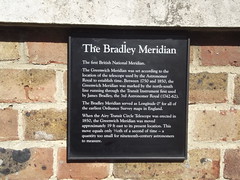James Bradley


James Bradley
(1693-1762)
astronomer and 3rd Astronomer Royal (1742-1762)
Commemorated on 2 plaques
In Wanstead James Bradley Third Astronomer Royal 1693-1762 was the first to demonstrate that the earth moves round the sun
Grove House, 2 Grove Park, Wanstead, E11, London, United Kingdom where they was
The Bradley Meridian The first British National Meridian The Greenwich Meridian was set according to the location of the telescope used by the Astronomer Royal to establish time. Between 1750 and 1850, the Greenwich Meridian was marked by the north-south line running through the Transit Instrument first used by James Bradley, the 3rd Astronomer Royal (1742-62). The Bradley Meridian served as Longitude 0° for all of the earliest Ordnance Survey maps of England. When the Airy Transit Circle Telescope was erected in 1850, the Greenwich Meridian was moved approximately 19 ft east to its present location. This move equals only 1/50th of a second of time - a quantity too small for ninteenth-century astronomers to measure.
Meridian Building - Royal Observatory Greenwich, London, United Kingdom where they was (1741-1761)


